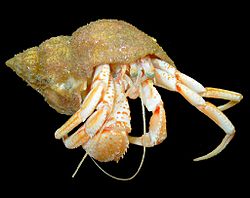| Paguridae | |
|---|---|
 | |
| Pagurus bernhardus | |
| Scientific classification | |
| Domain: | Eukaryota |
| Kingdom: | Animalia |
| Phylum: | Arthropoda |
| Class: | Malacostraca |
| Order: | Decapoda |
| Suborder: | Pleocyemata |
| Infraorder: | Anomura |
| Superfamily: | Paguroidea |
| Family: | Paguridae Latreille, 1802 |
The Paguridae are a family of hermit crabs of the order Decapoda. The king crabs, Lithodidae, are now widely understood to be derived from deep within the Paguridae, with some authors placing their ancestors within the genus Pagurus. [1] [ needs update ]